Canan Dağdeviren
Canan Dağdeviren (born May 4, 1985) is a Turkish academic, physicist, material scientist, and assistant professor at the Massachusetts Institute of Technology (MIT), where she currently holds the LG Career Development Professorship in Media Arts and Sciences. Dagdeviren is the first Turkish scientist in the history of the Harvard Society to become a Junior Fellow in the Society of Fellows at Harvard University. As a faculty member, she directs her own Conformable Decoders research group at the MIT Media Lab.[1] The group works at the intersection of materials science, engineering and biomedical engineering. They create mechanically adaptive electromechanical systems that can intimately integrate with the target object of interest for sensing, actuation, and energy harvesting, among other applications.[1] Dagdeviren believes that vital information from nature and the human body is “coded” in various forms of physical patterns. Her research focuses on the creation of conformable decoders that can “decode” these patterns into beneficial signals and/or energy.[1]
Canan Dağdeviren | |
|---|---|
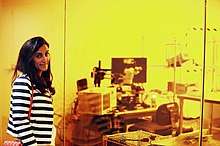 | |
| Born | 4 May 1985 Istanbul, Turkey |
| Education | Physics Engineering, Materials Science |
| Alma mater | |
| Known for | Electromechanical systems, microfabrication, conformable electronics, piezoelectric biomedical systems |
| Awards |
|
| Scientific career | |
| Fields | Materials Science, Physics, Bioengineering |
| Institutions | MIT, Harvard University |
| Doctoral advisor | |
| Other academic advisors |
|
Early life
Canan Dağdeviren was born in Istanbul, Turkey on May 4, 1985. She is the oldest of three, and has two younger brothers. She completed her primary education in İzmit, where she also attended middle school. However, her family was forced to leave the city after the 1999 İzmit earthquake, and she continued her high school education in Adana.
Dagdeviren was drawn to scientific exploration from a very young age. In an interview with Discover Magazine, she recalls being fascinated by smashing rocks together and producing sparks, saying “I loved the idea that you deform this material and create sparks -- it was very exciting.”[2] Another source of inspiration came from a book that her father gave her on the life of Marie Curie. She quickly became infatuated not just with Curie's work, but also with the research conducted by her husband Pierre Curie, who Dagdeviren considers her “scientific love.” Pierre and his brother Jacques first described piezoelectricity in 1880,[2] a concept that would later serve as the driving force behind many of Dagdeviren's own projects and applications.
Finally, at the heart of her work is Dagdeviren's own family. An early source of inspiration was learning about her grandfather, who died of heart failure at age 28. Even as a young girl, she promised herself that someday she would create technology that would decode and monitor similar health issues to honor his memory.[2]
Education & Academic Career
Canan Dagdeviren studied Physics Engineering at the Hacettepe University in Ankara, graduating in 2007. She obtained a Master of Science degree from Sabancı University in Istanbul, and won a Fulbright scholarship for study in the United States.[3] With this scholarship, she chose to conduct research in materials science and engineering at the University of Illinois at Urbana Champaign, where she focused on exploring patterning techniques and creating piezoelectric biomedical systems. Here, one of the projects that she developed was a conformable, piezoelectric, energy harvester that converts mechanical energy from internal organ movements into electric energy to power medical devices. It is soft and flexible and conforms to the heart as well as other soft tissues.[4] This technology could extend the battery life of implanted electronics or eliminate the need for battery replacement, sparing patients from repeated operations and the risk of surgical complications. In August 2014 she received her PhD degree.[5] Her advisor was John A. Rogers, and the title of her PhD thesis was Ferroelectric/Piezoelectric Materials Flexible/Stretchable/Wearable/Implantable Sensors, Actuators, Mechanical Energy Harvesters, Transducers, Microfabrication.[6]
Dagdeviren then went to Cambridge, MA to become a Junior Fellow in the Society of Fellows at Harvard University—the first Turkish scientist in the history of the Harvard Society to do so—as well as a postdoctoral research associate at MIT's Koch Institute for Integrative Cancer Research.[1] Her postdoctoral advisor was MIT Institute Professor Robert S. Langer.[7]
Currently, Dagdeviren is an Assistant Professor at MIT. She teaches a course on conformable devices every semester,[8] and also serves as a freshman advisor.
Recently, she was invited to present to the World.Minds community at the annual invitation-only symposium in Zurich, Switzerland. Her most recent research and achievements are summarized in her World.Minds talk.[9]
Projects & Publications
YellowBox

The YellowBox is a cleanroom used by Conformable Decoders at the MIT Media Lab, which Dagdeviren designed and constructed from the ground up in 2017.[10] When she was a PhD student, she promised herself that if she ever had the opportunity to build her own space, it would be physically transparent so that anyone passing by would have the ability to observe, take notes, and learn from her without needing any special permissions.[11] This inclusivity is part of what makes YellowBox such a unique scientific environment. Another unique aspect of YellowBox is that it is organized using 5S Methodology. 5S is a system which uses five guiding practices to organize a work space for efficiency and effectiveness: Sort, Set in Order, Shine, Standardize, and Sustain.[12] Essentially, 5S is an organizational methodology that uses visual labels—color-coded based on functionality—to organize spaces and increase safety, identifying potential hazards and procedural information.[12] As a result of this highly organized and efficient system, YellowBox achieved a Green Labs certification by Environmental Health & Safety (EHS) in 2017—the first research lab at the MIT Media Lab to receive this designation since its founding in 1985.[12] Recently, Dagdeviren published an article featured in Advanced Intelligent Systems describing her group's experience with greater efficiency, as a result of the 5S Methodology principles.[13]
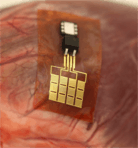
Conformal Piezoelectric Mechanical Energy Harvesters: Mechanically Invisible Human Dynamos (PZT MEH)
In 2014, Dagdeviren and her team developed conformal piezoelectric mechanical energy harvesters, which have been described as “mechanically invisible human dynamos.”[14] This project seeks to develop conformal piezoelectric patches integrated into personal garments to extract energy from body movements such as the motion of arms, fingers, and legs. In the future, this work could improve quality life for people and potentially provide environmentally friendly power. Since these energy harvesters are powered by human motion instead of battery power, the need for replacements and high risk/high cost surgical procedures to change depleted batteries could be eliminated.[14]
Flexible Piezoelectric Devices for Gastrointestinal Motility Sensing (PZT GI-S)
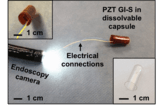
In 2017, the PZT GI-S project (essentially “a Fitbit for the stomach."[15]) was published. Dagdeviren and fellow collaborators designed an ingestible, flexible piezoelectric device that senses mechanical deformation within the gastric cavity. They demonstrated the capabilities of the sensor in both in vitro and ex vivo simulated gastric models, quantified its key behaviors in the gastrointestinal tract using computational modelling, and validated its functionality in awake and ambulating swine. The proof-of-concept device may lead to the development of ingestible piezoelectric devices that might safely sense mechanical variations and harvest mechanical energy inside the gastrointestinal tract for the diagnosis and treatment of motility disorders, as well as for monitoring ingestion in bariatric applications.[16]
Miniaturized Neural System For Chronic, Local Intracerebral Drug Delivery (MiNDS)
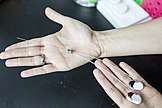
In 2018, Dagdeviren and her team developed an implantable, remotely controllable, miniaturized neural drug delivery system permitting dynamic adjustment of therapy with pinpoint spatial accuracy. Recent advances in medications for neurodegenerative disorders are expanding opportunities for improving the debilitating symptoms suffered by patients. Existing pharmacologic treatments, however, often rely on systemic drug administration, which result in broad drug distribution and consequent increased risk for toxicity. Given that many key neural circuitries have sub–cubic millimeter volumes and cell-specific characteristics, small-volume drug administration into affected brain areas with minimal diffusion and leakage is essential. Dagdeviren and her team demonstrates that this device can chemically modulate local neuronal activity in small-animal (rodent) and large-animal (nonhuman primate) models, while simultaneously allowing the recording of neural activity to enable feedback control[17].
Electronic Textile Conformable Suit (E-TeCS)

In 2020, Dagdeviren and her team created a tailored, electronic textile conformable suit (E-TeCS) to perform large-scale, multi-modal physiological (temperature, heart rate, and respiration) sensing in vivo [18]. The rapid advancement of electronic devices and fabrication technologies has further promoted the field of wearables and smart textiles. However, most of the current efforts in textile electronics focus on a single modality and cover a small area. E-TeCS introduces a new platform of modular, conformable (i.e., flexible and stretchable) distributed sensor networks that can be embedded into digitally-knit textiles. This platform can be customized for various forms, sizes and functions using standard, accessible and high-throughput textile manufacturing and garment patterning techniques.
Exhibitions
The Bees of Science
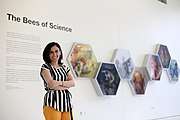
In June 2019, Dagdeviren blended media, art, and science to create an exhibition which was featured in the lobby of the Media Lab for 8 months. The exhibition displayed her students’ work, and was titled The Bees of Science. In a blog post, she explained “Like bees, my students work at the intersection of nature, art, and science, drawing on both their experiences in diverse fields of science and engineering and also their diverse cultural backgrounds, much as the bees draw nectar from a host of different flowers. They then apply their minds, hearts, and hands to create unique micro- and nano-scale, mechanically adaptive electromechanical systems for human health monitoring—their scientific “honey.”[19]
Awards & Honors
In 2014, Dagdeviren became the first Turkish scientist to be elected as a Junior Fellow of Harvard.[20]
In 2015, MIT Technology Review named her among the "Top 35 Innovators Under 35" (inventor category),[21] and Forbes magazine selected her as one of the "Top 30 Under 30 in Science."[22] The following year she received many honors, including being named a Gifted Citizen by Ciudad de las Ideas of Puebla, Mexico,[23] and the Spotlight Health Scholar by Aspen Institute. She placed first in the Medical Innovation Category of Ten Outstanding Young Persons of the World (TOYP) by Junior Chamber International (JCI),[24] and received the 2017 Innovation and Technology Delegate of the American Academy of Achievement Award.[25] Dagdeviren was also awarded the Science and Sci Life Prize for Young Scientists in Translational Medicine Category by Science/AAAS and SciLifeLab, and attended the Nobel Prize Ceremony in Stockholm, Sweden.[26]
Since beginning her current position at the MIT Media Lab, Dagdeviren and her students published a paper “Towards personalized medicine: the evolution of imperceptible healthcare technologies,” published in the November 2018 issue of Foresight, a journal of future studies, strategic thinking, and policy.[27] The paper was selected by the journal's editorial board as an Outstanding Paper for the 2019 Emerald Literati Awards.[28]
In 2019, Dagdeviren was awarded the Kadir Has University Promising Scientist Award,[29] and recognized in Fortune Turkey's “40 Under 40.”[30] She was also named as one of the United States's “87 brightest young engineers”[31] by the National Academy of Engineering (NAE), and took part in the NAE's 25th annual US Frontiers of Engineering (USFOE) Symposium.[32]
Media
Dagdeviren's work has been featured in many media outlets, including The Washington Post[33], IEEE Spectrum,[34] Forbes,[35] Discover Magazine,[2] MedGadget,[36] Stat News,[15] Nature Materials,[37] AP News[38] and more.
UN Talk
In addition to her work in the materials science and engineering fields, Dagdeviren seeks to inspire an upcoming generation of young scientists, specifically young women pursuing STEM careers.[39] She uses social media as a tool to connect with young minds across the globe, specifically through her Twitter, Instagram and Facebook accounts.
In February 2018, she was invited to speak at the Women in Science in Diplomacy for Sustaining Peace and Development event as part of the celebration of International Day of Women and Girls in Science at the United Nations.[40]
Since 2015, she has participated in numerous Women in Science and Engineering (WISE) panels across the globe and in various outreach activities that target women.
Personal
In an interview, Dagdeviren said that she was inspired for science by two books; a book on the life of the twice Nobel Prize-winning Polish-French physicist and chemist Marie Curie (1867–1934) and Turkish theoretical physicist Erdal İnönü’s (1926–2007) book of his memories (Anılar ve Düşünceler).[42] She also finds great inspiration in Rumi, a 13th-century Turkish poet who practiced Sufism—a movement to understand the universe under the lenses of sensation, beauty and love as well as care about integrity, dignity and sincerity.[43]
References
- "Conformable Decoders". Retrieved 10 February 2020.
- "How Flexible Sensors Might Begin to Read the Body's Language". Discover Magazine. Retrieved 2020-02-10.
- "Canan Dagdeviren - An Inspiring Story". U.S. Embassy & Consulates in Turkey. 2015-01-17. Retrieved 2020-02-10.
- "Canan Dagdeviren". Science | AAAS. 2016-12-01. Retrieved 2020-02-10.
- "Canan Dağdeviren kimdir?". Milliyet (in Turkish). Retrieved 2020-02-10.
- Dagdeviren, Canan (2015-01-21). Ferroelectric/piezoelectric flexible mechanical energy harvesters and stretchable epidermal sensors for medical applications (Thesis). University of Illinois at Urbana-Champaign. hdl:2142/73068.
- "The Koch Institute: Robert S. Langer". ki.mit.edu. Retrieved 2020-02-10.
- "Conformable Decoders". conformabledecoders.media.mit.edu. Retrieved 2020-02-10.
- "Canan Dağdeviren: Conformable Decoders (2019 WORLD.MINDS Annual Symposium)". YouTube.
- Dagdeviren, Canan. "Meet the YellowBox". MIT Media Lab. Retrieved 2020-02-10.
- Lab, MIT Media (2017-04-27). "Launching a lab". Medium. Retrieved 2020-02-10.
- Dagdeviren, Canan. "Managing a Lab". MIT Media Lab. Retrieved 2020-02-18.
- Dagdeviren, Canan (May 14, 2020). "Research Resiliency Through Lean Labs". Advanced Intelligence Systems. Retrieved May 18, 2020.
- "Conformable Decoders". conformabledecoders.media.mit.edu. Retrieved 2020-02-10.
- "Our bodies talk to us — and these implantable devices can help listen". STAT. 2018-06-29. Retrieved 2020-02-10.
- "Conformable Decoders". conformabledecoders.media.mit.edu. Retrieved 2020-02-10.
- "Miniaturized neural system for chronic, local intracerebral drug delivery". Science Translational Medicine. January 24, 2018.
- Trafton, Anne (2020-04-23). "Sensors woven into a shirt can monitor vital signs". MIT News. Retrieved 2020-05-01.
- Dagdeviren, Canan. "Exhibiting at the Media Lab: Canan Dagdeviren reflects on exhibiting student work". MIT Media Lab. Retrieved 2020-02-10.
- "Harvard's first Turkish junior follow invited to join MIT faculty". DailySabah. Retrieved 2020-02-10.
- Canan Dagdeviren - The Innovators Under 35 EmTech 2015 MIT Technology Review, retrieved 2020-02-10
- "Canan Dagdeviren, 29". Forbes. Retrieved 2020-02-10.
- Lagos, Anna (2016-11-18). "Gifted Citizen: los emprendedores sociales que cambian las reglas del juego". Entrepreneur (in Spanish). Retrieved 2020-02-10.
- "JCI". jci.cc. Retrieved 2020-02-10.
- "Academy of Achievement - Dr. Canan Dagdeviren" (PDF).
- "2016 Young Scientist Prize Winners". The Science & SciLifeLab Prize for Young Scientists. 2017-12-07. Retrieved 2020-02-10.
- Tasnim, Farita; Sadraei, Atieh; Datta, Bianca; Khan, Mina; Choi, Kyung Yun; Sahasrabudhe, Atharva; Vega Gálvez, Tomás Alfonso; Wicaksono, Irmandy; Rosello, Oscar; Nunez-Lopez, Carlos; Dagdeviren, Canan (2018). "Towards personalized medicine: the evolution of imperceptible health-care technologies". Foresight. 20 (6): 589–601. doi:10.1108/FS-08-2018-0075.
- Dagdeviren, Canan. "Outstanding Paper in the 2019 Emerald Literati Awards". MIT Media Lab. Retrieved 2020-02-10.
- Dagdeviren, Canan. "Canan Dagdeviren receives 2019 Kadir Has "Promising Scientist" Award". MIT Media Lab. Retrieved 2020-02-10.
- "'40 Yaş Altı 40′ Listesi - 2019". Fortune Turkey (in Turkish). Retrieved 2020-02-10.
- "Innovative Young Engineers Selected to Participate in NAE's 2019 U.S. Frontiers of Engineering Symposium". NAE Website. Retrieved 2020-02-10.
- Dagdeviren, Canan. "Dr. Canan Dagdeviren selected to participate in NAE's 2019 US Frontiers of Engineering Symposium". MIT Media Lab. Retrieved 2020-02-10.
- Choi, Charles (June 9, 2018). "How the body could power pacemakers and other implantable devices". the Washington Post.
- "Full Page Reload". IEEE Spectrum: Technology, Engineering, and Science News. Retrieved 2020-02-10.
- Brueck, Hilary. "Google Translate Buttons For Health Care Are Coming". Forbes. Retrieved 2020-02-10.
- "Decoding Physical Patterns of Our Bodies via Conformable Devices: Interview with MIT's Canan Dagdeviren |". Medgadget. 2019-07-24. Retrieved 2020-02-10.
- Lacour, Stéphanie P. (July 2015). "Skin health monitoring". Nature Materials. 14 (7): 659–660. doi:10.1038/nmat4328. ISSN 1476-4660. PMID 26099711.
- "Tiny implant opens way to deliver drugs deep into the brain". AP NEWS. 2018-01-24. Retrieved 2020-02-10.
- "Women in Engineering: An Interview with Canan Dagdeviren". www.wiley.com. Retrieved 2020-02-10.
- Dr. Canan Dağdeviren gives a talk at the United Nations, retrieved 2020-02-10
- "Blog". MIT Media Lab. Retrieved 2020-02-18.
- "Teaching in Turkey - A Morning with Dr. Canan Dağdeviren - From TAC - A Morning with Dr. Canan Dağdeviren - A Morning with Dr..." teachabroadturkey.com. Retrieved 2020-02-10.
- Canan Dağdeviren: Conformable Decoders (2019 WORLD.MINDS Annual Symposium), retrieved 2020-02-10